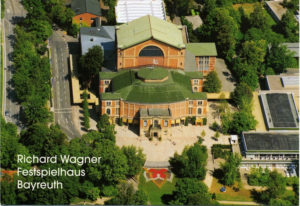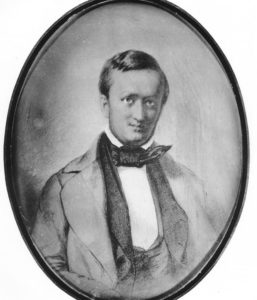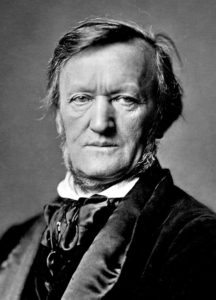
On August 17, 1876 – 144 years ago today – Richard Wagner’s music drama Götterdämmerung (“Twilight of the Gods”) received its premiere in his newly-opened “Festival Theater” in Bayreuth, Germany. That performance of Götterdämmerung brought to its conclusion the first production of Wagner’s epic four evening tetralogy, The Ring of the Niebelung.
Let’s say it up front because it needs to be said. That performance concluded what was and remains the greatest single undertaking in the history of Western music: not just Wagner’s writing and composition of the four music dramas that make up The Ring, but of the construction and opening of Wagner’s great shrine to himself: his custom-built Festival Theater in the Bavarian city of Bayreuth.
The Conception and the Creation of The Ring of the Nibelung

On May 16, 1849, an arrest warrant was issued by the Dresden police for the 36-year-old Richard Wagner (1813-1883). He was charged with treason due to his actions in the just terminated Dresden uprising, a charge that carried with it the death penalty. The warrant read as follows:
“Wagner is of medium stature, has brown hair, an open forehead; eyebrows, brown; eyes, grayish blue; nose and mouth, proportioned; chin, round, and wears spectacles. Special characteristics: rapid in movements and speech. Dress: coat of dark green buckskin, trousers of black cloth, velvet vest, silk neckerchief, felt hat and boots.”
The Dresden authorities were no match for Wagner, who by 1849 had become quite adept at surreptitious departures, accustomed as he was to bolting out of cities and disappearing into the night to avoid his many, many creditors. This time around he ended up in Switzerland, where he remained in “exile” until 1862, when the ban on his derriere was lifted and he could safely return to Germany.
It was during his early years in Switzerland that Wagner wrote a series of essays, essays that articulated the aesthetic principals that would govern his mature work.
Among these essay was one entitled A Communication to my Friends, written in 1851. It contains the following paragraph:
“I intend to present the myth of the Nibelung in three complete dramas (I have given up writing ‘operas’) with an extensive prelude. Although each of these dramas is a self-contained unit, they are not intended as individual ‘repertory pieces’ in the modern sense. Instead, I envisage a festival, specially arranged, at which each of the three dramas will be performed on a separate day, with the prelude on the first evening.”
It took him 25 long years, but Wagner’s vision became a reality. Never before or since has one person undertaken and completed so monumental a musical project as creating the four-music drama cycle known as The Ring and the Festival Theater associated with it.
The four music dramas of The Ring were first performed as an integral set in August of 1876 at Wagner’s newly constructed “Festival Opera House” in the Bavarian city of Bayreuth. A full 75 years before J. R. R. Tolkien completed his epic, four-volume set (in 1949), Richard Wagner was the “Lord of the Rings”. Wagner did everything: he wrote the words and composed the music; he designed and oversaw the construction of the theater, wrote the program notes, invented and commissioned the construction of special musical instruments for the performances, hired the singers, directed the productions, and apparently even hand-wrote the notices in the lavatories reminding employees to “wash hands before leaving”. (That’s true; no joke.)
Chronology
Wagner began writing the text of The Ring in 1848, while he was still the assistant Kapellmeister in Dresden. He initially completed the “poems” in December of 1852 – in Switzerland – and had them privately published in January of 1853. Wagner revised them over the years; it wasn’t until 1863 that all four of the texts were published with their present titles.
On November 1, 1853 Wagner began the “continuity sketch” of what he referred to as the “Prelude” to The Ring, the first of the four music dramas, entitled The Rheingold. Wagner finished the “fair copy” – his final, ink version – on September 25, 1854.
Meanwhile, he had been composing bits and pieces of the second music drama of The Ring – The Valkyries – as early as 1851. Its fair copy was completed on March 23, 1856.
During the summer of 1856, Wagner began working on Siegfried, the third music drama of the tetralogy. Having finished Act One and most of Act Two, he stopped working on Siegfried in August of 1857. Nearly fourteen years passed before Wagner completed Siegfried, on February 5, 1871.

Finally, Götterdämmerung – “The Twilight of the Gods” – was completed on November 21, 1874, a full 26 years after Wagner began writing the poems for The Ring.
The Ring was first performed as a complete cycle on August 13, 14, 16, and 17 of 1876.
Bayreuth
Along with completing The Ring, the early 1870s were, for Herr Wagner, taken up with the design, construction, and establishment of his Festival Theater, the Wagnerian cathedral to which the faithful could make pilgrimage and immerse themselves in the matchless glories of his genius.
Wagner had long before decided that he wanted to stage his festival somewhere in the southern German state of Bavaria, preferably in northern Bavaria, with easy access to the rest of Germany. He wanted to do it in a town that was not already identified with another artist. Finally, Wagner needed a town with a first-class opera house. In Bayreuth, Wagner believed he had found all three.
In April of 1870, Wagner visited Bayreuth and concluded that the opera house – despite having what was reputed to be the largest stage in Germany – was inadequate to his needs. So he decided there and then to buy land and build his own theater.
If we were talking about anybody else, we’d laugh.
In order to raise the fortune that would be necessary, Wagner embarked on fundraising tours across Germany. He sold “patronage certificates” – what amounted to “seat licenses” – with which subscribers could buy the “right” to purchase tickets. He launched “Wagner Societies” to raise money and to promote subscriptions. Twice he appealed directly to the German Prime Minister – Otto von Bismarck – for funds (and twice he was turned down: in 1871 and 1873).
Nevertheless, by early 1872, the land was bought. At 11 o’clock in the morning of May 22, 1872 – Wagner’s 59th birthday – the cornerstone of the theater was laid in a ceremony accompanied by pouring rain.
There was a problem, though. You see, Wagner didn’t have the money to actually build the theater; the laying of the “cornerstone” was a sham, just another bit of Wagnerian theater. Nevertheless, he moved to Bayreuth, managed, somehow, to buy another plot of land on which he announced he would build his own “villa”, and figured that somehow, someway, the necessary money would “materialize.”
If we were talking about anybody else, we’d laugh.

In December of 1873, with the project facing bankruptcy, a desperate Wagner was forced to play his trump card. He travelled to the Bavarian capital of Munich and asked the Bavarian King – Ludwig II (1845-1886) – to underwrite the project. This is the same Ludwig II – also-known-as the “Swan King” and the “Mad King” – that in 1864 had rescued Wagner from penury, paid off his debts, and made his future work possible.
Ludwig was born in the Nymphenburg Castle outside of Munich on August 25, 1845. As a child he was enthralled by the Teutonic legends of Tannhäuser, Lohengrin, and the Knights of the Grail, all of which were eventual subjects of Wagner music dramas.
Ludwig’s infatuation with the music and prose writings of Richard Wagner began when he was 12 years old and only grew in intensity as he got older. The 18-year-old Leopold was particularly taken by a passage in the preface to Wagner’s newly published, 1863 edition of his poem The Ring of the Nibelung. In the preface Wagner wrote that only through the beneficence of a German Prince could his plans for a festival theater become a reality:
“By this act [this prince] would found an institution which would assuredly earn him an immeasurable influence on German artistic taste, on the development of the German artistic genius, on the formation of a true national spirit, and which would bestow eternal renown on his name.
Is such a prince to be found?”
Just months after having read those very words, Ludwig became King of Bavaria when his father, King Maximilian II, died on March 10, 1864.
“Is such a prince to be found?” Wagner asked. Yes, indeed, and that Prince – that King – was Ludwig II.
Among Ludwig’s first acts as King was to arrange a meeting with Wagner himself, which took place at 10am on the morning of May 3, 1864. That meeting altered the course of Wagner’s life. Ludwig paid off Wagner’s mountain of debt, provided him a villa on Lake Starnberger not far from his palace, sponsored the premieres of Tristan and Isolde and The Mastersingers of Nuremburg, and commissioned the completion of the Ring Cycle for the king’s-ransom sum of 30,000 Florins.
With Ludwig, Wagner had struck paydirt, and he parlayed the King’s fawning adoration into mountains of cash and no small degree of political influence. But by December of 1773, when Wagner approached Leopold and asked him to finance the theater at Bayreuth, the king had – for reasons far too numerous to recount here – soured on Wagner. So, to Wagner’s utter amazement, Ludwig actually turned him down.
It looked like “lights out” for Wagner and his crazy project.
And then, a few weeks later – in January of 1874 – Ludwig changed his mind. The King wrote to Wagner:
“From the depths of my heart I beg you to forgive me. Do not be angry with me, dearest friend. No, no a thousand times no! The matter cannot end like this. We must find help. Our plan cannot be allowed to fail!”
“Our” plan? Okay, whatever, “our plan.” Within a month a “loan” had been arranged for 100,000 thalers – back when a thaler meant something! – and Wagner was back in business. King Ludwig’s bailout was the turning point. With success now guaranteed, a significant portion of the European artistic community came to Wagner’s aid, staging benefit performances and sending the proceeds to Wagner.
To the amazement of everyone, Wagner pulled it off; he designed and built his theater and created his festival around the Ring Cycle. The general sense of wonder at it all was perfectly expressed by Kaiser Wilhelm I, who said to Wagner on arriving at Bayreuth for that first festival in August 1876:
“I never thought you would bring your plan to fruition, but now the sun has bathed your achievement in radiance.”
That it did, though Wagner’s wife Cosima went to her grave believing that stress over the theater cost Wagner 20 years of life. On returning home from a performance during that 1876 premiere of The Ring, Wagner remarked to his wife that:
“Every stone in that building is red with my blood and yours.”
We, today, should see Wagner’s enterprise for what it was: a miracle of creativity, perseverance, and no doubt, luck. In the 2½ years from the time Ludwig rescued the festival to its opening, Wagner and his team devised and built a new theater of revolutionary design in order to perform a cycle of four evening-length music dramas the likes of which had never been heard before; they built Wagner’s massive villa (which he named Wahnfried meaning “Dream Fulfillment”); designed the productions, hired and rehearsed the orchestra and singers, created the costumes and built the sets and stage machinery from scratch.
There were problems. My favorite is the one surrounding the dragon that Siegfried fights and slays in Siegfried. It was built in London and shipped to Bayreuth in pieces. Unfortunately, the thing’s neck never arrived; it had accidentally been shipped to Beirut (in Lebanon) instead of Bayreuth (in Bavaria).
Such inevitable mishaps aside, the first festival came off. The music dramas themselves are, as we all know, quite long and extremely difficult to perform, and many (if not most) of the attendees didn’t entirely understand them. But from the first there was a sense that something new and significant was taking place, whether or not one “liked the music.”

“Ring” festivals – during which the Ring Cycle is performed across the span of a single week – are presented to this day across the globe (or at least will once again be, after the pandemic). No matter what one thinks of Wagner the man, he was an artist and visionary of unique gifts. It is my opinion that like the Hajj for a Muslim, every music lover should make pilgrimage and attend a Ring Cycle at least once in his/her lifetime. If you can do this at the Bayreuth Festival Theater, all the better: there is not a bad seat in the 1,925 seat house.
For lots more on Wagner and his Ring Cycle, I would direct your attention to my Great Courses/Teaching Company Survey “The Music of Richard Wagner”.
Listen on the Music History Monday Podcast
Podcast: Play in new window
Subscribe: Apple Podcasts | Spotify | Pandora | iHeartRadio | RSS | More
